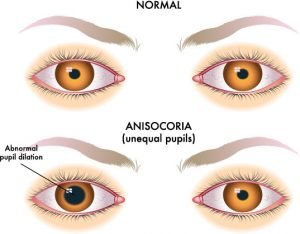
- #Unequal pupil size following a head injury how to#
- #Unequal pupil size following a head injury professional#
Numbness or tingling in your extremities.The Glasgow Coma Scale was first published in 1974 at the University of Glasgow by neurosurgery professors Graham Teasdale and Bryan Jennett. You should also see a doctor if you experience other neurological symptoms in conjunction with fixed, dilated pupils, such as: You experience trauma to one or both of your eyes. You have pupils of unequal size (one pupil is larger/smaller than the other). One or both of your pupils do not react to light properly. You notice a sudden, unexplained change in pupil size. SEE RELATED: Marcus Gunn pupil (RAPD): Causes, types, signs and treatment When to see a doctorįixed, dilated pupils can be a sign of serious, life threatening conditions and should be treated as a medical emergency.
#Unequal pupil size following a head injury how to#
Results from an MRI or CT scan will inform your doctor on how to approach treatment in the best, most effective way. Testing may include magnetic resonance imaging (MRI) or computed tomography (CT or CAT scan) to provide pictures of the brain. In this case, a neurologist or neuro-ophthalmologist will be called and additional testing may be required. If it’s determined that the blown pupil(s) are a side effect of medication or chemical exposure, your doctor will likely want to monitor your condition for a day or two to make sure no other symptoms, such as ptosis, appear.Įxamination may reveal that the blown pupils are caused by problems in the brain.
#Unequal pupil size following a head injury professional#
A medical professional can assess your symptoms, determine the severity of the situation and prescribe appropriate treatment. Treatment for fixed, dilated pupils depends solely on the cause. Other symptoms associated with this include: The most obvious symptom of blown pupils is having one or both pupils that appear abnormally dilated (large) and do not react to light. Use of anticholinergic drugs, which block neurotransmitters and suppress nerve impulses that cause involuntary muscle movements.Įxposure to plants or other objects that contain these chemicals, such as angel’s trumpet plant, jimson weed and belladonna. Pharmacological blockade, which is a topical drug (usually eye drops) administered before an eye exam. Less serious causes of fixed, dilated pupils include: Trauma or compression of the upper brain stem and third cranial nerve, which is responsible for eye muscles and movement (oculomotor function). Serious causes of fixed, dilated pupils include: The risk involved with a blown pupil is too great to go untreated. While some causes are non-life threatening and may resolve on their own, medical attention is recommended. SEE RELATED: Miosis (pupil constriction) Blown pupil causesįixed, dilated pupils can be caused by several factors. However, exposure to certain substances can also elicit the reaction. Typically blown pupils occur as a response to a brain injury, such as head trauma or stroke. Unilateral cases, where only one pupil is dilated and fixed, is known as anisocoria, meaning unequal pupil size. The largely dilated pupil may affect one eye (unilateral) or both eyes (bilateral). In other words, mydriasis is a temporary dilation of the pupils in response to light.īlown pupils are dilated very widely and fixed, meaning they do not respond to an outside stimulus, such as light. However, once you step out of the dark room, your pupils will return to normal or adjust to the new level of brightness. For instance, when you enter a dark room, your pupils will naturally dilate (get larger) to adjust to a low-light environment. Mydriasis is the eye’s inherent response to stimuli. The key difference between blown pupils and mydriasis is pretty simple: One is a natural, normal response and the other is not. People who notice a sudden, unexplained change in pupil size should see an eye doctor, especially if only one pupil is affected.

Typically, blown pupils are seen in response to brain damage caused by trauma or stroke, though less serious causes are possible. When it occurs, a fixed dilated pupil may be present in one or both eyes. A blown, or blown out, pupil is characterized by a pupil that is largely dilated and unresponsive to light.


 0 kommentar(er)
0 kommentar(er)
